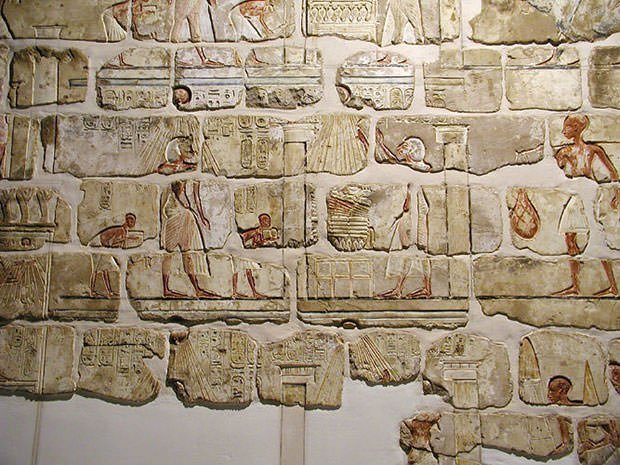Akhenaten is one of the most famous pharaohs of Ancient Egypt. Also known as Amenhotep IV, he ruled over Egypt for seventeen years during fourteenth century BC. Here are 10 interesting facts about the radical pharaoh who introduced monotheism to the world. Also know why Akhenaten and his religion may be related to Moses and Judaism.
#1 HIS FATHER Was AMENHOTEP THE MAGNIFICENT
Born Amenhotep, Akhenaten was the son of Amenhotep III and Tiye. Amenhotep III, also known as Amenhotep the Magnificent, was the ninth pharaoh of the Eighteenth dynasty of Ancient Egypt and had a long and prosperous reign. Tiye was Amenhotep III’s Great Royal Wife, the title given to the principal wife of the pharaoh. Their eldest son Crown Prince Thutmose died before Amenhotep III thus making Akhenaten next in line for the throne.

#2 HE RULED OVER ANCIENT EGYPT FOR 17 YEARS
Akhenaten ruled as Amenhotep IV for the first few years of his reign. Amenhotep IV was crowned in Thebes. The date of his succession to the throne is not known with certainty and varies between 1370 BC and 1358 BC. His reign lasted for seventeen years till his death in 1336 BC or 1334 BC. Amenhotep IV was pharaoh of the Eighteenth dynasty of Ancient Egypt.
#3 HE WAS THE HUSBAND OF THE FAMOUS NEFERTITI
Amenhotep IV married Nefertiti at the beginning of his reign. From inscriptions it can be deduced that Nefertiti and Akhenaten had at least six daughters. Though Nefertiti was not his only wife, Akhenaten is shown openly displaying love for Nefertiti and their daughter in depictions. Most probably, the couple had a genuine romantic relationship. Nefertiti became an icon of feminine beauty after the rediscovery of her bust in 1912.

#4 HE INSTITUTED THE FIRST MONOTHEISTIC RELIGION IN HISTORY
When Amenhotep IV came to the throne, many gods were worshipped in Egypt with Amun being the King of Gods. Initially he allowed worship of Egypt’s traditional deities but soon he took steps to establish sun god Aten as the supreme god of Egypt. By year 9 of his reign Akhenaten declared that Aten was not merely the supreme god, but the only god. This was a radical step and the first instance of monotheism in all history.

#5 HE TOOK THE NAME AKHENATEN IN YEAR FIVE OF HIS REIGN
In year 5 of his reign that Amenhotep IV disbanded priesthoods of all the other gods, rejected the primary god Amun as superstition and replaced the traditional image of falcon as the symbol of deity with the sun disk. To show his loyalty to Aten, he changed his name from Amenhotep, which meant ‘Amun is content’, to Akhenaten, meaning ‘Living Spirit of Aten’.
#6 HE ORDERED ERADICATION OF ALL OF EGYPT’S TRADITIONAL GODS
In year 9 of his reign, Akhenaten ordered the eradication of all of Egypt’s traditional gods. He ordered the defacing of Amun’s temples throughout Egypt and imposed a ban on images except the ones which referred to Aten. By these measures he tried to instill in people that Aten was the one true god. He also declared that he was the only intermediary between Aten and the people of Egypt thus eliminating the priests.

#7 HE IS THE FOUNDER OF THE CITY OF AMARNA
In year 5 of his reign Akhenaten ordered the construction of his new capital which was named Akhetaten or ‘Horizon of Aten’. Akhetaten was dedicated to his new religion of worship to the Aten. The temples built there were roofless so that rays of the sun would fall on the worshipers. The site today is known as Amarna. It is one of the most important historical sites in Egypt and exploration of the city continues to this day.

#8 ART WAS REVOLUTIONIZED DURING His REIGN
Akhenaten presided over one of the wealthiest period of ancient Egypt. Numerous structures were constructed during his reign, the most famous being the Temple of Amenhotep IV. Art was revolutionized during his reign with more realistic artistic portrayals. It was radical for its time as it focused on ordinary activities and domestic scenes. Also royal women became more prominent in portrayals of the period.

#9 AKHENATEN AND ATENISM WERE ERASED FROM RECORDS AFTER HIS DEATH
After the death of Akhenaten, his monotheistic religion was discarded and traditional religious practices were gradually restored. He was referred to as the ‘heretic king’ and all traces to him and Atenism were erased. His name doesn’t appear in any of the king lists compiled by later Pharaohs and it was only after the discovery of the site of Amarna in the nineteenth century that the world came to know about Akhenaten.

#10 AKHENATEN WAS THE FATHER OF KING TUT
One of Akhenaten’s sons was Tutankhaten. Tutankhaten went on to become pharaoh and took the name Tutankhamun. He became famous when his nearly intact tomb was discovered in 1922 and is now popularly known as King Tut. Previously it was not certain that King Tut was the son of Akhenaten but DNA tests in 2010 established this fact. It is also now known that King Tut’s mother was a biological sister of Akhenaten and one of his wives.

AN INTERESTING THEORY
Since Akhenaten was the first monotheist, there is a theory that after his death his followers were forced to leave Egypt and were led by an Atenist priest who was the biblical Moses. That Akhenaten’s monotheist religion later went on to become Judaism cannot be definitely established. However there are several points that support this theory including the fact that three principal Judaic terms for God have a connection to Aten.


The Bible wasn’t created by man yet. You fools. LOL